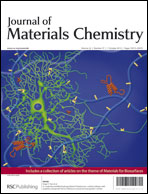Antisite defects in Ce-doped YAG (Y3Al5O12): first-principles study on structures and 4f–5d transitions
Abstract
The interactions between Ce3+ and antisite defects (AD) in YAG (Y3Al5O12) are studied by means of first-principles calculations: periodic-boundary-conditions density-functional-theory for a 160 atom YAG unit cell with one Ce3+ and one or two ADs, and complete-active-space second-order perturbation theory for the 4f1, 5d1, and 6s1 electronic manifolds of the (CeO8Al2O4)15− embedded cluster. Attractive interactions are found between Ce3+ and the ADs. The formation of one AD is more favorable in Ce:YAG than in YAG, but the formation of a second AD is less favorable, which means that the presence of Ce tends to lower the concentration of antisite defects in YAG. The interaction between Ce3+ and antisite defects blueshifts the two lowest Ce3+ 4f → 5d transitions. This result rules out the involvement of antisite defects in the recently reported excitation of the lowest 5d → 4f emission with


 Please wait while we load your content...
Please wait while we load your content...